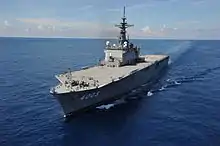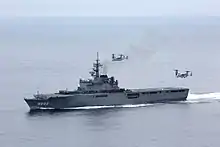Ōsumi-class tank landing ship
The Ōsumi class LST (おおすみ型輸送艦), is a Japanese amphibious transport dock. The class is also known as the Oosumi class. While the JMSDF describes the Ōsumi class as tank landing ships, they lack the bow doors and beaching capability traditionally associated with LSTs. Functionally, their well deck makes the Ōsumi class more like a dock landing ship (LSD).
.jpg.webp) JS Ōsumi | |
| Class overview | |
|---|---|
| Builders: | |
| Operators: | Japan Maritime Self-Defense Force |
| Preceded by: | Miura-class |
| Built: | 1993-1999 |
| In commission: | 1998-present |
| Planned: | 3 |
| Completed: | 3 |
| Active: | 3 |
| General characteristics | |
| Class and type: | Amphibious transport dock |
| Displacement: | 8,900 tons standard 14,000 tons full load |
| Length: | 178 m |
| Beam: | 25.8 m |
| Draught: | 17.0 m |
| Draft: | 6.0 m |
| Propulsion: |
|
| Speed: | 22 knots (41 km/h) |
| Complement: | 138 crews + (330 troops) |
| Sensors and processing systems: | OPS-14C air search radar,OPS-28D surface search radar,OPS-20 navigation radar, TACAN |
| Electronic warfare & decoys: | 4 × Mark 36 SRBOC |
| Armament: |
2 × 20 mm Phalanx CIWS 2 × 12.7mm machine gun M2 |
| Aircraft carried: | up to 8 helicopters tied topside |
| Notes: |
|
As of 2014 there are 3 Ōsumi vessels active with the Japanese Maritime Self-Defence Force.
Design and specifications

.jpg.webp)

GlobalSecurity.org noted in its report on the Ōsumi class that "the program originated in a proposal for a small carrier for defensive and mine countermeasures (MCM) purposes, but this was deemed politically unacceptable, and the project was reworked as an amphibious ship" (actually a “Maritime Operational Transport", see below). Later the JMSDF returned to the idea with helicopter carriers with the larger Hyūga class.
The Ōsumi class increases its carrying capacity with a flat-top open air upper vehicle parking deck, it has an elevated island superstructure offset to starboard giving the appearance of a small aircraft carrier though the helicopter flight deck only comprises the stern of the ship. Small deck elevators accessing the enclosed lower parking deck are for vehicles rather than helicopters, the lower vehicle deck has access to the well deck. There is no enclosed aircraft hangar and any helicopters are tied down topside.[1]
The MSDF developed the Maritime Operational Transport concept as an alternative to what was then (mid-1990s) the politically denied development of an amphibious doctrine. This concept is intended to "deliver JGSDF reinforcement units to an area where an enemy landing is possible or probable, or where an enemy has already landed but that is still under Japanese control. The point is that the landings would be on Japanese territory, not foreign soil. So, in theory, this concept does not involve amphibious assault. The tempo of helicopter transport and the types of helicopters required would be very different from those in an assault amphibious landing."[2]
Osumi gives the JMSDF a modest lift capability, especially in defense of the outer islands. The "Osumi" type of vessel enables the efficient transport of ground troops to strategic locations, and the rescue of civilians in case of large scale natural disaster. The massive hull features armored and opening deck. The rear of hull houses an armored landing deck for two large CH-47 helicopters. The well-dock in the rear of the ship houses the two Landing Craft Air Cushion (LCAC) hovercraft. Forward, there is a 100m deck below the main deck, but the single elevator accessing these spaces is too small for anything but a small helicopter. A VSTOL aircraft or a larger helicopter will simply not fit on the elevator. These spaces below the forward main deck are used primarily for vehicle storage so those fighting and/or armored vehicles can access the well deck.
At least two members of the class, JDS Ōsumi (LST-4001) and JDS Kunisaki (LST-4003), participated in search & rescue and other disaster relief operations in the aftermath of the 2011 Tōhoku earthquake and tsunami.
In January 2014, The Japanese Ministry of Defence (MoD) has confirmed reports that it will perform a major refit on the Japan Maritime Self-Defense Force's (JMSDF's) Osumi-class tank landing ships (LST) to embark MV-22 Ospreys, and Assault Amphibious Vehicles (AAV7s) to improve their amphibious capabilities. The MoD allocated JPY20 million (US$190,000) in its fiscal year 2014 budget to conduct research on the refit. [3]
In 2014, Japanese Defense Minister Itsunori Onodera expressed the intention of buying one amphibious assault ship from the United States to provide more amphibious capabilities than the current Osumi class landing ships. The Wasp class amphibious assault ship is most likely candidate for acquisition.[4]
Ships in the class
| Pennant No. | Name | Home port | Unit | Shipyard | Plan | Laid down | Launched | Commissioned |
|---|---|---|---|---|---|---|---|---|
| LST 4001 | Ōsumi | Kure | Landing Div 1 | Mitsui, Tamano | 1993 | 6 December 1995 | 18 November 1996 | 11 March 1998 |
| LST 4002 | Shimokita | 1998 | 30 November 1999 | 29 November 2000 | 12 March 2002 | |||
| LST 4003 | Kunisaki | Hitachi, Maizuru | 1999 | 7 September 2000 | 13 December 2001 | 26 February 2003 |
Gallery
- Ōsumi-class
.jpg.webp) JS Ōsumi
JS Ōsumi JS Shimokita
JS Shimokita.jpg.webp) JS Kunisaki
JS Kunisaki Three Ōsumi-class underway in formation in 2008.
Three Ōsumi-class underway in formation in 2008.
References
- Pike, John. "LST Osumi Class". globalsecurity.org. Retrieved 12 February 2017.
- Yoji Koda, “Jieikan no Genyu Seiryoku to Shyorai Tenbo” [The Present and Future of JMSDF Ships], in Sekai no Kansen (January 2009), p. 129
- "readdailynews.com". Retrieved 12 February 2017.
- "Onodera sets out plans to buy amphibious assault ships". Retrieved 24 December 2014.
External links
| Wikimedia Commons has media related to Ōsumi class LST. |